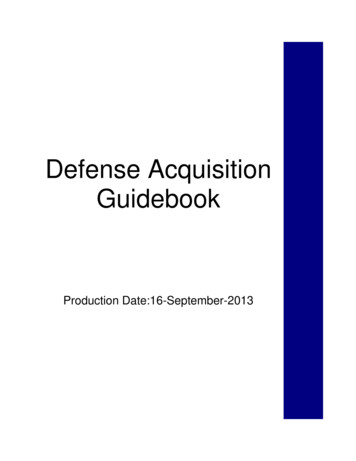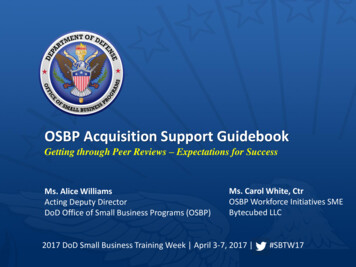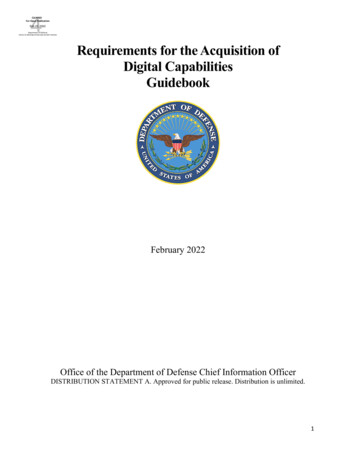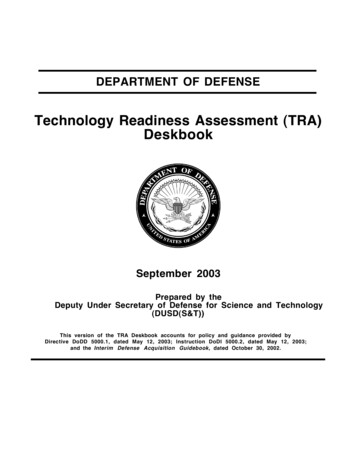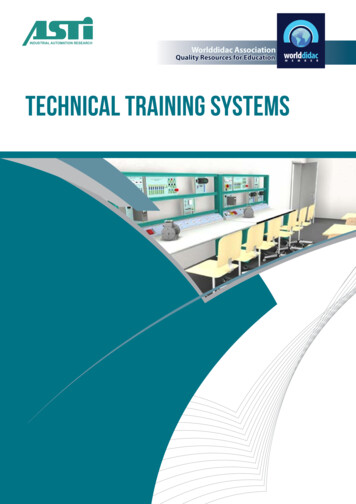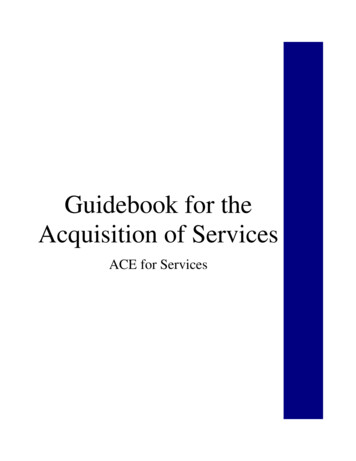
Transcription
Guidebook for theAcquisition of ServicesACE for Services
TABLE OF CONTENTSI Introduction to the Acquisition of ServicesI.1 The Services Acquisition ProcessI.2 What is a Service Requirement?I.3 Non-Personal Services RequirementsI.4 Personal Services RequirementsI.5 Preference for Performance-Based Acquisitions (PBA) for ServicesI.6 Objectives of Performance-Based Acquisition (PBA)I.7 Principles of Performance-Based Acquisition (PBA) for Service RequirementsII THE PLANNING PHASEStep One Form the Team1.1 Ensure Senior Management Involvement and Support1.2 Form the Team and Team Charter1.3 Identify and Analyze Stakeholders, Nurture Consensus1.4 Develop a Communication Plan1.5 Develop and Maintain Knowledge Base over the Project Life1.6 Plan and Schedule Topical Team TrainingStep Two Review Current Strategy2.1 Identify Current Initiatives/Contracts2.2 Review and Document Current Level of Performance2.3 Begin Program Risk Identification2.4 Document Current Processes2.5 Determine Status of Government Furnished Property/Materials/Facilities
2.6 Stakeholder Submits Current and Projected Requirements Forecast2.7 Review Current/Statutory Requirements2.8 Define (at a High Level) Desired Results2.9 Review Current Performance and Desired Results with Stakeholders and Users2.10 Refine Desired Results and Validate with StakeholdersStep Three Market Research3.1 Take a Team Approach to Market Research3.2 Determine Data Sources3.3 Develop a Standardized Interview Guide3.4 Conduct Market Research3.4.1 Customers3.4.2 Consider One-on-One Meetings with Industry3.4.3 Look for Existing Contracts3.5 Request Information From Service Providers3.6 Analyze Market Research3.7 Document Market Research and TrendsIII THE DEVELOPMENT PHASEStep Four Requirement Definition4.1 Conduct Performance Risk Analysis4.2 Conduct a Requirements Analysis4.3 Build Requirements Roadmap4.3.1 Acceptable Quality Levels (AQLs)4.3.2 Performance Assessment Strategies
4.3.3 Performance Assessment Personnel4.3.4 Assessment Methods4.3.5 Contractor's Quality Control Plan4.3.6 Create Your Performance Reporting Structure4.4 Standardize Requirements Where Possible to Leverage Market Influence4.5 Develop a Performance Work Statement (PWS) and Statement of Objectives (SOO)4.5.1 Format4.5.2 Best Practices and Lessons Learned for Developing PWS4.5.3 Style Guidelines for Writing PWS4.5.4 Reviewing your PWS4.6 Develop Quality Assessment Surveillance Plan (QASP) Outline4.7 Develop Independent Government Estimate (IGE) Based on Projected Demand Forecast4.8 Establish Stakeholder ConsensusStep Five Develop an Acquisition Strategy5.1 Develop Preliminary Business Case and Acquisition Strategy5.2 Finalize Acquisition Strategy5.2.1. Types of Contracts5.2.1.1. Fixed-Price Contract Types5.2.1.2. Cost Reimbursement Contract Types5.2.2. Incentives - Recognize the Power of Profit as a Motivator5.2.2.1. Positive and Negative Incentive Examples5.2.2.2. Considerations When Contemplating Incentives5.2.3. Determine How You Will Select a Contractor
5.3 Allocate Workload Within the Acquisition Team5.4 Prepare Acquisition Planning Documents5.5 Consider use of Draft Request for Proposal (RFP)IV THE EXECUTION PHASEStep Six Execute the Strategy6.1 Issue Request for Proposal (RFP) or Military Interdepartmental Purchase Request (MIPR)6.2 Conduct Source Selection6.2.1. Instructions to Offerors6.2.2. Section L6.2.3. Section M Evaluation Factors for Award6.2.4. Relationship between PWS, Section L, and Section M6.2.5. Role of Past Performance in Best Value Procurements6.3 Pre-Award Approval Documents6.4 Contract Award6.5 Debrief Unsuccessful Offerors6.6 Finalize Quality Assurance Surveillance Plan (QASP)6.7 Post-Award Implementation/TransitionStep Seven Performance Management7.1 Transition to Performance Management7.2 Manage and Administer Overall Program7.2.1 Monitor Contract Performance7.2.2 Submit CPARS report7.3 Manage Performance Results
7.4 Conduct Quarterly Supplier and Key Stakeholders Performance Reviews7.5 Evaluate Effectiveness of StrategyAppendix A: Requirements Roadmap WorksheetAppendix B: Service Acquisition Project PlanAppendix C: Service Acquisition Mall (SAM)Appendix D: Market Research ResourcesAppendix E: GlossaryLIST OF FIGURESFigure 1-1: The Services Acquisition ProcessFigure 1-2: Model of Step OneFigure 2-1: Model of Step TwoFigure 3-1: Model of Step ThreeFigure 4-1: Model of Step FourFigure 4-2: Risk Analysis ModelFigure 4-3: Requirements Roadmap WorksheetFigure 4-4: Performance IndicatorsFigure 5-1: Model of Step FiveFigure 6-1: Model of Step SixFigure 7-1: Model of Step SevenFigure 7-2: Performance IndicatorsFigure A-1: Requirements Roadmap WorksheetFigure D-1: Model of SAMLIST OF TABLES
Table 1-1: Performance OutcomesTable 4-1: Sections L and M Relationship ExampleI INTRODUCTION TO THE ACQUISITION OF SERVICESThe acquisition of services plays a vital role in advancing and maintaining the mission capabilityof the Department of Defense (DoD). Services acquisition covers a broad spectrum ofrequirements from research and development, advisor services, information technology support,medical, to maintaining equipment and facilities. For over ten years the DoD has spent more onservice requirements than it has on equipment acquisitions. While the acquisition of majorsystems follows a much defined process, the acquisition of services tends to be more ad hoc.Services acquisition is not about awarding a contract; it's about acquiring performance resultsthat meet performance requirements needed to successfully execute an organization's mission.This guidebook provides acquisition teams with a disciplined, seven step process, for theacquisition of services. Applying this rigorous and systematic approach requires the dedicatedeffort of an acquisition team composed of functional experts, contracting specialists, contractingofficer representatives, and others working together to achieve performance results and valuetheir mission requirements. It's important to remember that the Federal Acquisition Regulation(FAR) states that the acquisition process is a shared "team responsibility". Completing thisprocess, like all acquisitions, takes allocated planning time. Getting your acquisition teamorganized and focused early in the process is a fundamental key to successfully achieving themission results your customers require.I.1 The Services Acquisition ProcessWhen does the process start? It starts with a valid mission requirement for a service essential forthe successful execution of the organization's mission. The process continues through a planningphase, which develops the foundation for defining your requirement and business strategy, andultimately ends with the delivery and assessment of the services provided.The service could be provided by a new contract you develop; it could be provided by an alreadyexisting contract within your agency (or outside your agency); or could be part of your agency'sstrategic sourcing efforts. The services acquisition process requires that you keep an open mindabout where best to source the requirement until you have explored and assessed all thealternatives and developed a clear picture of the requirement and supporting acquisition strategy.The services acquisition process has three phases.
Planning Phase:Step One: Form the TeamStep Two: Review Current StrategyStep Three: Market ResearchDevelopment Phase:Step Four: Requirements DefinitionStep Five: Acquisition StrategyExecution Phase:Step Six: Execute StrategyStep Seven: Performance ManagementEach phase builds on the knowledge gained in the previous phase. Some actions within eachphase can be completed in parallel; others should be completed sequentially to make moreinformed decisions based on new knowledge gained. The project plan in Appendix B will helpyou tailor a plan for your service acquisition. This guidebook will cover each of the steps indetail and illustrate how to use the requirements roadmap tool to assist you in developingperformance-based requirements documents.The process is pictured below in Figure 1-1.Figure 1-1: The Services Acquisition Process
The Planning Phase , steps 1, 2, and 3, lays the foundation for action. During the planningphase, you form the acquisition team and get leadership support for all the actions that musthappen to ensure the mission is supported. Baseline and analyze your current service strategies;identify problem areas and projected mission changes; and get your stakeholders to define theirkey performance outcomes for this requirement. Also analyze the market place to assess currenttechnology and business practices, competition and small business opportunities, existing andpotential new sources of providing the service, and determine if commercial buying practices canbe adapted.During the Development Phase , steps 4 and 5, use the requirements roadmap process to defineyour High Level Objectives and tasks, standards, allowable variations, and method of inspection.After completing the roadmap you will then be in the best position to develop a performancework statement (PWS) and quality assurance surveillance plan (QASP). During this phase youwill also identify your funding sources, develop a government estimate of contract price for therequired service, and get industry feedback on your working documents.Finally, synthesize an acquisition strategy that leverages contract type and performanceincentives to deliver a best value mission performance to the customer. The basic performanceprinciple is to tell the contractor what the performance results are, not how to do the job. Letindustry develop the solution.In the Execution Phase , steps 6 and 7, you put all your planning and development efforts intoaction. You create a solicitation document that formally communicates to industry yourrequirements and strategy. You receive contractor proposals for how they will meet yourperformance results and standards and then evaluate them against criteria selected that will bestdetermine the success of a potential contractor's approach. After contract award, the businessrelationship you have with the service providing contractor should foster innovation andimprovements to mission performance outcomes. This part of the process involves two keyareas: administering contract requirements such as invoicing and payments; and managing therelationships and expectations of both the contractor and customers in meeting the terms of thecontract and achieving the required mission performance results. You also start the planningphase for a follow-on acquisition if there is a continuing need for the service being provided.I.2 What is a Service Requirement?A service requirement's primary purpose is to perform an identifiable task rather than furnish anend item of supply. Its primary purpose directly engages a contractor's time and effort. A servicerequirement may be either non-personal or personal and performed by professional ornonprofessional workers whether on an individual or organizational basis. Some of the areas inwhich service requirements are found include the following: Maintenance, overhaul, repair, servicing, rehabilitation, salvage, modernization, ormodification of supplies, systems, or equipmentRoutine recurring maintenance of real property
Housekeeping and base servicesAdvisory and assistance services (A&AS)Operation of government-owned equipment, facilities, and systemsCommunication servicesArchitect-engineering (see FAR part 36.6 )Transportation and related services (see FAR part 47 )Research and development (see FAR part 35 )The contracting officer is responsible for determining whether the services needed are nonpersonal or personal using the definitions found in FAR 37.101 and 37.4 and the guidelinesfound in FAR 37.104 . Agencies shall not award personal service contracts unless specificallyauthorized by statute to do so.I.3 Non-Personal Services RequirementsNon-personal service means that the personnel rendering the services are not subject, either bythe contract's terms or by the manner of its administration, to the supervision and control usuallyprevailing in relationships between the government and its employees. Non-personal servicecontracts are authorized by the government in accordance with FAR 37.102 , under generalcontracting authority, and do not require specific statutory authorization.I.4 Personal Services RequirementsA personal service is characterized by the employer-employee relationship it creates between thegovernment and the contractor's personnel. The government is normally required to obtain itsemployees by direct hire under competitive appointment or other procedures required by the civilservice laws. Obtaining personal services by contract, rather than by direct hire, circumventsthose laws unless Congress has specifically authorized acquisition of the services by contract asindicated in FAR 37.104 .In a personal services contract, the contractor is considered to be, and is treated as, an employeeof the government. In this type of relationship, a government officer or employee directlysupervises and controls the contractor's personnel on a continuing basis. Personal servicecontracts require specific authorization.I.5 Preference for Performance-Based Acquisitions (PBA) for ServicesThe FAR, in implementing public law 106-398, states that performance based acquisitionmethods should be used to the maximum extent practicable. PBA for services involvesperformance requirements and acquisition strategies that describe and communicate measurable
outcomes rather than direct specific performance processes. It is structured around defining aservice requirement in terms of performance resultss and providing contractors the latitude todetermine how to meet those objectives. Simply put, it is a method for acquiring what results arerequired and placing the responsibility for how it is accomplished on the contractor.To be considered performance-based, an acquisition should contain, at a minimum, the followingelements: PWS - Describes the requirement in terms of measurable outcomes rather than by meansof prescriptive methods.Measurable performance standards -Determines whether performance outcomes havebeen met; defines what is considered acceptable performance.Incentives / Disincentives - Addresses how to manage performance that does not meet (orexceed) performance standards. While not mandatory, incentives should be used, whereappropriate, to encourage performance that will exceed performance standards.Incentives can be both monetary and non-monetary.QASP - Describes how the government will assess contractor performance against theperformance standards contained in the PWS.I.6 Objectives of Performance-Based Acquisition (PBA)By describing requirements in terms of performance outcomes, agencies can help achieve thefollowing objectives:Maximize performance : Allows a contractor to deliver the required service by following itsown best practices. Since the prime focus is on the end result, contractors can adjust theirprocesses, as appropriate, through the life of the contract without the burden of contractmodifications, provided the delivered service (outcome) remains in accordance with the contract.The use of incentives further motivates contractors to continue to exceed minimum contractperformance requirements.Maximize competition and innovation : Encouraging innovation from the supplier base byusing performance requirements maximizes opportunities for competitive alternatives in lieu ofgovernment-directed solutions. Since PBA allows for greater innovation, it has the potential toattract a broader industry base.Encourage and promote the use of commercial services : The vast majority of servicerequirements are commercial in nature. Use of FAR Part 12 (Acquisition of Commercial Items)procedures provides great benefits by minimizing the reporting burden and reducing the use ofgovernment-unique contract clauses and similar requirements, which can help attract a broaderindustry base.Shift in risk : Much of the risk is shifted from the government to industry, since contractorsbecome responsible for achieving the performance results contained in the PWS through the use
of their own best practices and processes. Agencies should consider this shift in responsibility indetermining the appropriate acquisition incentives and contract type.Achieve savings : Experience in both government and industry has demonstrated that use ofperformance requirements results in cost savings.I.7 Principles of Performance-Based Acquisition (PBA) for Service RequirementsPBA is not a new procurement strategy. Many procurement activities have never stopped usingPBA techniques. The Department of the Navy, as one example among many, has used PBAtechniques effectively for facilities maintenance services for decades. The Department of the AirForce and the Army Corps of Engineers has employed PBA techniques in many of their serviceacquisitions.PBA techniques are applicable to a broad range of service requirements. Simply stated, PBAmethods structure a contract around the contractor achieving stated performance results andstandards. The contractor's performance against the required standards must be measurablethrough an objective process. This means that the government acquisition team must describe therequired performance results in clearly defined terms with performance standards that can beeffectively measured. This is often the most difficult part of implementing PBA techniques.Writing a PWS in a way that describes performance results requires us to focus on therelationship between what needs to be done and how well it must be accomplished, not how itmust be accomplished or how many full-time equivalents (FTEs) are required. When PBAtechniques are not appropriate for use, the decision shall be documented and included in thecontract file.Let's examine a couple of examples of writing a requirement that focus on achieving a specifiedoutcome rather than how to perform the function. The Navy decided to outsource its ordering,inventory management, and delivery of aircraft tires. They could have developed a detailedspecification on how to order, inventory, and deliver aircraft tires. What the Navy did was toreview what performance outcomes the fleet needed to support aircraft operations around theworld. Through this review and analysis they developed the following performance objectives,performance standards, and acceptable level of deviation depicted in Table 1-1.Table 1-1: Performance Outcomes Performance ObjectivePerformance ObjectiveDeliver any Navy aircraft tire requiredwithin CONUSDeliver any Navy aircraft tire requiredoutside the CONUSPerformanceStandardAQL orToleranceWithin 48 Hours95% On TimeWithin 96 Hours95% On Time
With this simple set of performance outcomes, contractors were given wide latitude to developan ordering, inventory, and delivery methodology to support Navy flying operations. Throughthe innovation introduced by industry the Navy achieved the following benefits: 3M per year in supply chain management savingsReduction from approximately 1.5 years wholesale inventory to three monthsReduction from 60 days to 15 days retail inventory at all Continental United States (U.S.)(CONUS) Naval Air StationsResponse times reduced to two days in U.S., four days outside CONUS (OCONUS)On-time delivery improvement from 81% to 99 %Over 49 million net savings to the Navy over life of contractAnother example of the challenges you'll face in developing performance outcomes is illustratedby an example from the Corps of Engineers. The Corps had developed a comprehensiveStatement of Work (SOW) for a dredging requirement. It specified where to dredge, how todredge, when to dredge, and provided little opportunity for innovation; after all it's just dredging,right. So let's step back and try to understand what the real requirement was. Why was thedredging required? Was that the real requirement? Isn't dredging a process to achieve anobjective or outcome? After some prolonged and heated discussion, they determined that thedredging was required so that shipping could proceed through a specified channel withoutunderwater obstructions. In other words keeping the channel open was their performanceobjective, not dredging.With this new focus, the next question was how well or to what standard must the channel bekept (not dredging)? The answer was 100 feet wide and 12 feet deep mean low water. Now theyhad a performance standard, but how would they know if the contractor was meeting thatperformance standard? Their answer was providing a boat with a global positioning system(GPS) and sonar system that could measure depth and position to ensure the channel met thespecified standard. With their new performance objective, performance standard, and a means ofinspection, they were well on their way to developing a simpler, more performance-basedrequirement.No matter where you are in the services acquisition process, it's very easy to get trapped into apreconceived idea of how a particular function should or must be performed. Like the examplescited above, you need to keep the focus on what mission outcomes you are trying to achieve, nothow the process must be accomplished. If you can keep a higher view of what you're asking acontractor to accomplish, you will have far more success in implementing a performance-basedapproach for your service requirements.
Step One Form the TeamThe acquisition team should be a customer-focused, multi-functional team that plans andmanages the service requirement throughout its life cycle. We will refer to the multi-functionalteam as the acquisition team during this guide. The requirement may be for a single function orfor multiple functions. Estimated dollar value is not the sole determinant of the amount of effortdevoted to the acquisition. Previously, it was common for contracting and other functionalexperts to work independently in "functional stove pipes" when acquiring services. This methodis outdated and costly. Service acquisition requires a team effort. It is essential that allstakeholders be involved throughout the service acquisition life cycle, from the planning anddevelopment phase through the execution phase. The duties, expertise, and contributions of eachteam member are important to the success of any service acquisition. Many functional expertsshould make up an acquisition team.1.1 Ensure Senior Management Involvement and SupportEarly in your acquisition efforts you should make sure you've got senior leadership support. It isimportant to understand leadership's concerns and expectations for your acquisition. Whatpriority does this requirement have in their portfolio of service requirements? Your leadership
can help you get the right people on your team and overcome roadblocks when necessary whenthey understand your team is committed to the success of their mission.1.2 Form the Team and Team CharterThe goal of every acquisition team should be to obtain quality, timely contract services in both alegal and cost-effective manner, placing the responsibility for quality performance on thecontractor. Nonetheless, achieving this goal can be challenging. The interdisciplinary nature ofyour acquisition efforts means no single individual or function is likely to have all the requisiteknowledge and experience in the majority of cases. Therefore, personnel such as the programmanager, contracting officer, contracting officer's representative (COR), responsible fiscalofficer, and legal counsel (among others) should form the acquisition team as soon as possible inorder to: Develop a team vision and charter for the acquisition.Develop an effective level of dialogue and teamwork.Analyze stakeholders and create a communication plan.Develop a project plan and the timeline for the acquisition. A project plan provides thedetail of what has to be accomplished and who is responsible to accomplish each task.Although the composition of the acquisition team may vary depending on the nature of therequirement, a few key members are essential to the success of any contract. They are as follows:The Customer/User: The customer's representative or functional manager normally brings to theteam detailed knowledge of the user requirements. They are responsible for defining the requiredperformance outcomes or results. The requirements definition most likely will include anassessment of the risk that the government might assume when relying on commercialspecifications and common marketplace performance and quality standards. The customer/userplays an important role in deciding what tradeoffs are necessary when considering acommercially available service to fulfill an agency requirement. Your customer/user is the keyindividual in determining the organization's needs and in providing the historical data andperspective.Program Manager/Technical Specialist/Project Manager: The program manager (PM) is theacquisition team leader and is responsible for ensuring that the acquisition plan is properlyexecuted and the desired results are achieved. The PM provides coordination and facilitatescommunication among the acquisition team members, closely tracks the milestone schedule, andprovides leadership and guidance to overcome and resolve any problems or delays. Thisindividual is responsible for drafting the PWS, which means ensuring that performancerequirements are clearly and concisely defined and articulated. PMs identify, plan, and controlvarious areas, such as delivery requirements, scheduling, market research, COR nomination, costestimating, budgeting, and specific project formulation. The PM normally participates in thesource selection as well. This individual serves as the principal technical expert, is most familiar
with the requirement, best able to identify potential technical tradeoffs, and whether therequirement can be met by a commercial solution.The Contracting Officer: The warranted contracting officer is responsible for performing allrelevant contract functions, to include assisting in requirements development and marketresearch. Within this context, the contracting officer does not determine the government's need,but is responsible for advising the PM in preparing a PWS. This individual serves as theprincipal business advisor and principal agent for the government responsible for developing thebusiness strategy, solicitation, conducting the source selection, and administrating the resultantcontract and business arrangement.Performance Assessment Personnel (Quality Assurance Personnel): Performance assessmentpersonnel are known by many names, such as COR, or contracting officer's technicalrepresentative (COTR), or quality assurance evaluator (QAE), but their duties are essentially thesame. They serve as the on-site technical manager responsible for assessing actual contractorperformance against contract performance standards. The COR provides the team with their fieldexperience and surveillance of service contracts (Frequently, this individual is the same personwho initiates the program requirements and normally serves as the primary person responsiblefor assessing performance). They provide guidance to the PM to ensure contract requirements aredescribed in a manner which enables the government to objectively and effectively assess thecontractor's work performance in terms of outcome. They serve as the "eyes and ears" of thecontracting officer and when applicable, the COR performs the actual surveillance of thecontractor's work. A letter of appointment signed by the contracting officer provides scope andlimitations of the COR's authority.Small Business Specialist (SBS): The SBS serves as the principal advisor and advocate for smallbusiness engagement. This individual serves as the chief analyst on small business laws,regulations and command policy. They can provide insight for market research and anunderstanding of industry small business capability. He or she may also serve as the liaison withthe Small Business Administration (SBA).Cost/Price Analyst: The cost/price analyst evaluates the financial price and cost-based data forreasonableness, completeness, accuracy, and affordability. Alternatively, some agencies utilizecost engineering personnel from within an engineering division to conduct cost/price analysisfrom a technical standpoint.Finance/Budget Officer: The finance/budget officer serves as an advisor for fiscal and budgetaryissues.Legal Advisor: The legal advisor ensures that the commercial practices, and terms and conditionscontemplated are consistent with the government's legal rights, duties, and responsibilities; willreview the acquisition documents for legal sufficiency; and provides advice on acquisitionstrategies and contract terms to the PBA team.Miscellaneous Others: In addition to individuals mentioned above, personnel from outside theagency may also be useful, depending on their area of expertise. This includes individuals from
agencies such as the Defense Contract Management Agency, Defense Logistics Agency, theDefense Contract Audit Agency, and the Environmental Protection Agency, to name a few.Team Charter and Vision StatementDeveloping a team charter is an important step in getting the team focused on the objectives tobe accomplished and to assign key roles and responsibilities. Everyone involved must understandhow they will contribute to achieving the required mission results. The charter starts with theacquisition team's vision statement. The vision statement should capture the high level objectiveof the team's effort and be an objective that unites the team.Use the project plan (Appendix B) and tailor it for your specific acquisition. This will help youidentify all the actions needed to complete each step of the seven step process. It also enablesyou to assign responsibility for specific actions and develop a time line
strategic sourcing efforts. The services acquisition process requires that you keep an open mind about where best to source the requirement until you have explored and assessed all the alternatives and developed a clear picture of the requirement and supporting acquisition strategy. The services acquisition process has three phases.

